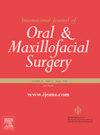A new patient-specific helical maxillary distractor: a cadaver test
IF 2.2
3区 医学
Q2 DENTISTRY, ORAL SURGERY & MEDICINE
International journal of oral and maxillofacial surgery
Pub Date : 2025-02-01
DOI:10.1016/j.ijom.2024.05.008
引用次数: 0
Abstract
The primary objective of this cadaver study was to assess the feasibility of a novel custom helical distraction system and a patient-specific antral maxillary distractor. The study involved two fresh cadaver heads and followed a systematic procedure. First, virtual planning was conducted for an asymmetric maxillomandibular advancement. Custom patient-specific hardware was then fabricated to enable sequential mandibular advancement and gradual maxillary distraction. The mandibular lengthening procedures were found to be highly accurate, with only minor deviations from the planned results. In terms of maxillary distraction, the patient-specific antral distractors demonstrated favorable outcomes, with two noteworthy exceptions. Ideal forward maxillary advancement was short by a modest 2–3 mm in both cadavers. Additionally, cadaver 2 exhibited an unplanned pitch malrotation. However, an excellent occlusion was achieved in cadaver 1 and an acceptable anterior occlusion in cadaver 2, albeit with bilateral posterior open bites that could be readily corrected with interdental elastics in a clinical setting. This cadaver model study provides compelling evidence for the feasibility of patient-specific antral helical distractors, highlighting their potential to yield positive outcomes. Importantly, the study results suggest that patient-specific antral distractors may offer superior results compared to the current standard of linear distractors.
新型患者专用螺旋上颌骨牵引器:尸体试验。
这项尸体研究的主要目的是评估新型定制螺旋牵引系统和患者专用上颌前牙牵引器的可行性。该研究涉及两个新鲜的尸体头部,并遵循一个系统的程序。首先,对不对称上下颌前突进行虚拟规划。然后根据患者的具体情况定制硬件,以实现下颌顺序推进和上颌逐渐牵引。结果发现,下颌延长术的精确度很高,与计划结果仅有轻微偏差。在上颌牵引方面,患者专用的前牙牵引器显示出良好的效果,但有两个值得注意的例外。在两个尸体中,理想的上颌骨前移都略微短了 2-3 毫米。此外,尸体 2 出现了意外的俯仰不正。不过,尸体1的咬合非常好,尸体2的前牙咬合也可以接受,尽管有双侧后牙开放咬合,但在临床环境中可以很容易地用牙间橡皮矫正器进行矫正。这项尸体模型研究为患者特异性前牙螺旋牵引器的可行性提供了令人信服的证据,凸显了其产生积极结果的潜力。重要的是,研究结果表明,与目前标准的线性牵引器相比,患者特异性前牙牵引器可能会提供更好的效果。
本文章由计算机程序翻译,如有差异,请以英文原文为准。
求助全文
约1分钟内获得全文
求助全文
来源期刊
CiteScore
5.10
自引率
4.20%
发文量
318
审稿时长
78 days
期刊介绍:
The International Journal of Oral & Maxillofacial Surgery is one of the leading journals in oral and maxillofacial surgery in the world. The Journal publishes papers of the highest scientific merit and widest possible scope on work in oral and maxillofacial surgery and supporting specialties.
The Journal is divided into sections, ensuring every aspect of oral and maxillofacial surgery is covered fully through a range of invited review articles, leading clinical and research articles, technical notes, abstracts, case reports and others. The sections include:
• Congenital and craniofacial deformities
• Orthognathic Surgery/Aesthetic facial surgery
• Trauma
• TMJ disorders
• Head and neck oncology
• Reconstructive surgery
• Implantology/Dentoalveolar surgery
• Clinical Pathology
• Oral Medicine
• Research and emerging technologies.

 求助内容:
求助内容: 应助结果提醒方式:
应助结果提醒方式:


